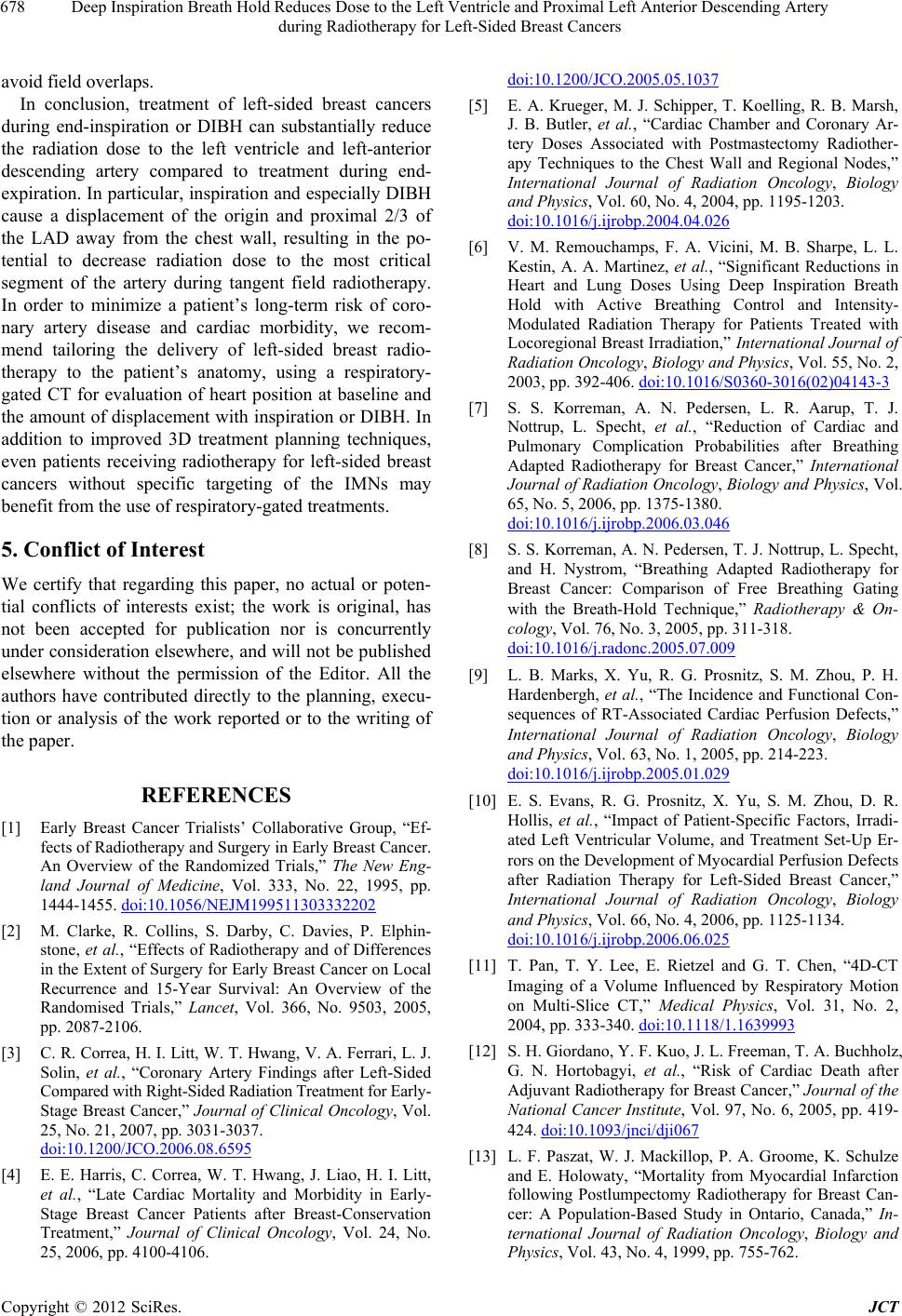
Deep Inspiration Breath Hold Reduces Dose to the Left Ventricle and Proximal Left Anterior Descending Artery
during Radiotherapy for Left-Sided Breast Cancers
678
avoid field overlap s.
In conclusion, treatment of left-sided breast cancers
during end-inspiration or DIBH can substantially reduce
the radiation dose to the left ventricle and left-anterior
descending artery compared to treatment during end-
expiration. In particular, inspiration and especially DIBH
cause a displacement of the origin and proximal 2/3 of
the LAD away from the chest wall, resulting in the po-
tential to decrease radiation dose to the most critical
segment of the artery during tangent field radiotherapy.
In order to minimize a patient’s long-term risk of coro-
nary artery disease and cardiac morbidity, we recom-
mend tailoring the delivery of left-sided breast radio-
therapy to the patient’s anatomy, using a respiratory-
gated CT for evaluation of heart position at baseline and
the amount of displacement with inspiration or DIBH. In
addition to improved 3D treatment planning techniques,
even patients receiving radiotherapy for left-sided breast
cancers without specific targeting of the IMNs may
benefit from the use of respiratory-gated treatments.
5. Conflict of Interest
We certify that regarding this paper, no actual or poten-
tial conflicts of interests exist; the work is original, has
not been accepted for publication nor is concurrently
under consideration elsewhere, and will not be published
elsewhere without the permission of the Editor. All the
authors have contributed directly to the planning, execu-
tion or analysis of the work reported or to the writing of
the paper.
REFERENCES
[1] Early Breast Cancer Trialists’ Collaborative Group, “Ef-
fect s o f Ra di ot he r apy and Sur gery i n Ea r ly Bre ast Ca nc er .
An Overview of the Randomized Trials,” The New Eng-
land Journal of Medicine, Vol. 333, No. 22, 1995, pp.
1444-1455. doi:10.1056/NEJM199511303332202
[2] M. Clarke, R. Collins, S. Darby, C. Davies, P. Elphin-
stone, et al., “Effects of Radiotherapy and of Differences
in the Extent of Surgery for Early Breast Cancer on Local
Recurrence and 15-Year Survival: An Overview of the
Randomised Trials,” Lancet, Vol. 366, No. 9503, 2005,
pp. 2087-2106.
[3] C. R. Correa, H. I. Litt, W. T. Hwang, V. A. Ferrari, L. J.
Solin, et al., “Coronary Artery Findings after Left-Sided
Compared with Right-Sided Radiation Treatment for Early-
Stage Breast Cancer,” Journal of Clinical Oncology, Vol.
25, No. 21, 2007, pp. 3031-3037.
doi:10.1200/JCO.2006.08.6595
[4] E. E. Harris, C. Correa, W. T. Hwang, J. Liao, H. I. Litt,
et al., “Late Cardiac Mortality and Morbidity in Early-
Stage Breast Cancer Patients after Breast-Conservation
Treatment,” Journal of Clinical Oncology, Vol. 24, No.
25, 2006, pp. 4100-4106.
doi:10.1200/JCO.2005.05.1037
[5] E. A. Krueger, M. J. Schipper, T. Koelling, R. B. Marsh,
J. B. Butler, et al., “Cardiac Chamber and Coronary Ar-
tery Doses Associated with Postmastectomy Radiother-
apy Techniques to the Chest Wall and Regional Nodes,”
International Journal of Radiation Oncology, Biology
and Physics, Vol. 60, No. 4, 2004, pp. 1195-1203.
doi:10.1016/j.ijrobp.2004.04.026
[6] V. M. Remouchamps, F. A. Vicini, M. B. Sharpe, L. L.
Kestin, A. A. Martinez, et al., “Significant Reductions in
Heart and Lung Doses Using Deep Inspiration Breath
Hold with Active Breathing Control and Intensity-
Modulated Radiation Therapy for Patients Treated with
Locoregional Breast Irradiation,” International Journal of
Radiation Oncology, Biology and Physics, Vol. 55, No. 2,
2003, pp. 392-406. doi:10.1016/S0360-3016(02)04143-3
[7] S. S. Korreman, A. N. Pedersen, L. R. Aarup, T. J.
Nottrup, L. Specht, et al., “Reduction of Cardiac and
Pulmonary Complication Probabilities after Breathing
Adapted Radiotherapy for Breast Cancer,” International
Journal of Radiation Oncology, Biology and Physics, Vol.
65, No. 5, 2006, pp. 1375-1380.
doi:10.1016/j.ijrobp.2006.03.046
[8] S. S. Korreman, A. N. Pedersen, T. J. Nottrup, L. Specht,
and H. Nystrom, “Breathing Adapted Radiotherapy for
Breast Cancer: Comparison of Free Breathing Gating
with the Breath-Hold Technique,” Radiotherapy & On-
cology, Vol. 76, No. 3, 2005, pp. 311-318.
doi:10.1016/j.radonc.2005.07.009
[9] L. B. Marks, X. Yu, R. G. Prosnitz, S. M. Zhou, P. H.
Hardenbergh, et al., “The Incidence and Functional Con-
sequences of RT-Associated Cardiac Perfusion Defects,”
International Journal of Radiation Oncology, Biology
and Physics, Vol. 63, No. 1, 2005, pp. 214-223.
doi:10.1016/j.ijrobp.2005.01.029
[10] E. S. Evans, R. G. Prosnitz, X. Yu, S. M. Zhou, D. R.
Hollis, et al., “Impact of Patient-Specific Factors, Irradi-
ated Left Ventricular Volume, and Treatment Set-Up Er-
rors on the Development of Myocardial Perfusion Defects
after Radiation Therapy for Left-Sided Breast Cancer,”
International Journal of Radiation Oncology, Biology
and Physics, Vol. 66, No. 4, 2006, pp. 1125-1134.
doi:10.1016/j.ijrobp.2006.06.025
[11] T. Pan, T. Y. Lee, E. Rietzel and G. T. Chen, “4D-CT
Imaging of a Volume Influenced by Respiratory Motion
on Multi-Slice CT,” Medical Physics, Vol. 31, No. 2,
2004, pp. 333-340. doi:10.1118/1.1639993
[12] S. H. Giordano, Y. F. Kuo, J. L. Freeman, T. A. Buchholz,
G. N. Hortobagyi, et al., “Risk of Cardiac Death after
Adjuvant Radiotherapy for Breast Cancer,” Journal of the
National Cancer Institute, Vol. 97, No. 6, 2005, pp. 419-
424. doi:10.1093/jnci/dji067
[13] L. F. Paszat, W. J. Mackillop, P. A. Groome, K. Schulze
and E. Holowaty, “Mortality from Myocardial Infarction
following Postlumpectomy Radiotherapy for Breast Can-
cer: A Population-Based Study in Ontario, Canada,” In-
ternational Journal of Radiation Oncology, Biology and
Physics, Vol. 43, No. 4, 1999, pp. 755-762.
Copyright © 2012 SciRes. JCT